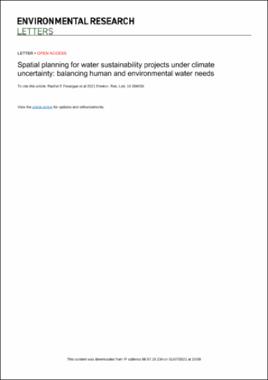| dc.contributor.author | Fovargue, Rachel E. | |
| dc.contributor.author | Rezapour, Shabnam | |
| dc.contributor.author | Rosendahl, Derek | |
| dc.contributor.author | Wootten, Adrienne M. | |
| dc.contributor.author | Sabzi, Hamed Zamani | |
| dc.contributor.author | Moreno, Hernan A. | |
| dc.contributor.author | Neeson, Thomas M. | |
| dc.date.accessioned | 2021-07-01T19:32:01Z | |
| dc.date.available | 2021-07-01T19:32:01Z | |
| dc.date.issued | 2021-03-02 | |
| dc.identifier.citation | Rachel E Fovargue et al 2021 Environ. Res. Lett. 16 034050 | en_US |
| dc.identifier.uri | https://hdl.handle.net/11244/330117 | |
| dc.description.abstract | Societies worldwide make large investments in the sustainability of integrated human-freshwater systems, but uncertainty about water supplies under climate change poses a major challenge. Investments in infrastructure, water regulation, or payments for ecosystem services may boost water availability, but may also yield poor returns on investment if directed to locations where water supply unexpectedly fluctuates due to shifting climate. How should investments in water sustainability be allocated across space and among different types of projects? Given the high costs of investments in water sustainability, decision-makers are typically risk-intolerant, and considerable uncertainty about future climate conditions can lead to decision paralysis. Here, we use mathematical optimization models to find Pareto-optimal satisfaction of human and environmental water needs across a large drought-prone river basin for a range of downscaled climate projections. We show how water scarcity and future uncertainty vary independently by location, and that joint consideration of both factors can provide guidance on how to allocate water sustainability investments. Locations with high water scarcity and low uncertainty are good candidates for high-cost, high-reward investments; locations with high scarcity but also high uncertainty may benefit most from low regret investments that minimize the potential for stranded assets if water supply increases. Given uncertainty in climate projections in many regions worldwide, our analysis illustrates how explicit consideration of uncertainty may help to identify the most effective strategies for investments in the long-term sustainability of integrated human-freshwater systems. | en_US |
| dc.description.sponsorship | The project described in this publication was supported by the Science Applications division of the Southwest Region of the US Fish and Wildlife Service, and by Grant No. G17AP00120, Balancing Water Usage and Ecosystem Outcomes Under Drought and Climate Change: Enhancing an Optimization Model for the Red River, from the United States Geological Survey. Open Access fees paid for in whole or in part by the University of Oklahoma Libraries. | en_US |
| dc.language | en_US | en_US |
| dc.rights | Attribution 4.0 International | * |
| dc.rights.uri | https://creativecommons.org/licenses/by/4.0/ | * |
| dc.subject | Spatial planning | en_US |
| dc.subject | Water sustainability projects | en_US |
| dc.subject | Climate Uncertainty | en_US |
| dc.subject | Climate Change | en_US |
| dc.subject | Uncertainty | en_US |
| dc.subject | Integrated human-natural systems | en_US |
| dc.subject | Water availability | en_US |
| dc.subject | Environmental Flows | en_US |
| dc.title | Spatial planning for water sustainability projects under climate uncertainty: balancing human and environmental water needs | en_US |
| dc.type | Article | en_US |
| dc.description.peerreview | Yes | en_US |
| dc.identifier.doi | 10.1088/1748-9326/abdd58 | en_US |
| ou.group | College of Atmospheric and Geographic Sciences::Department of Geography and Environmental Sustainability | en_US |

